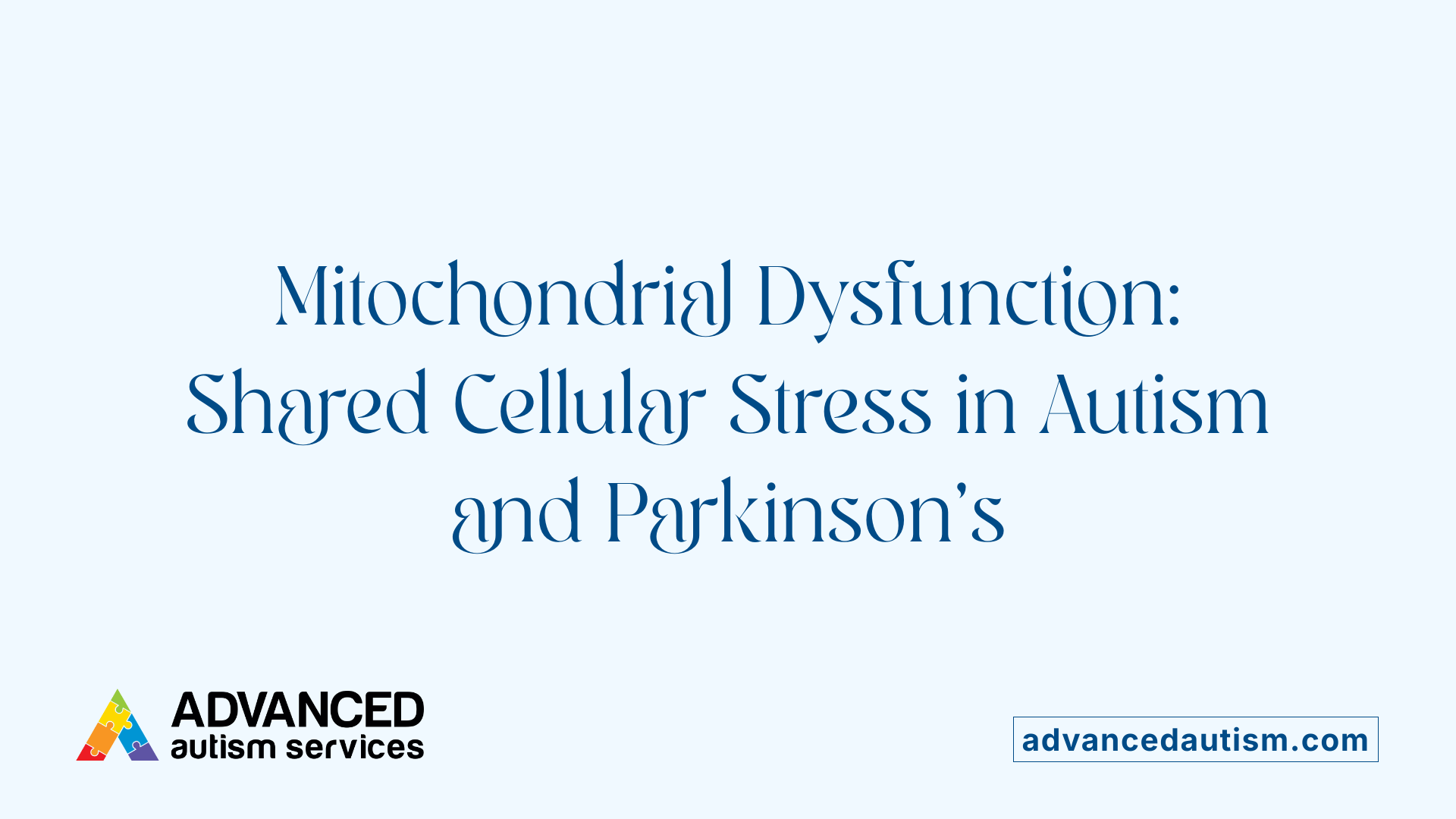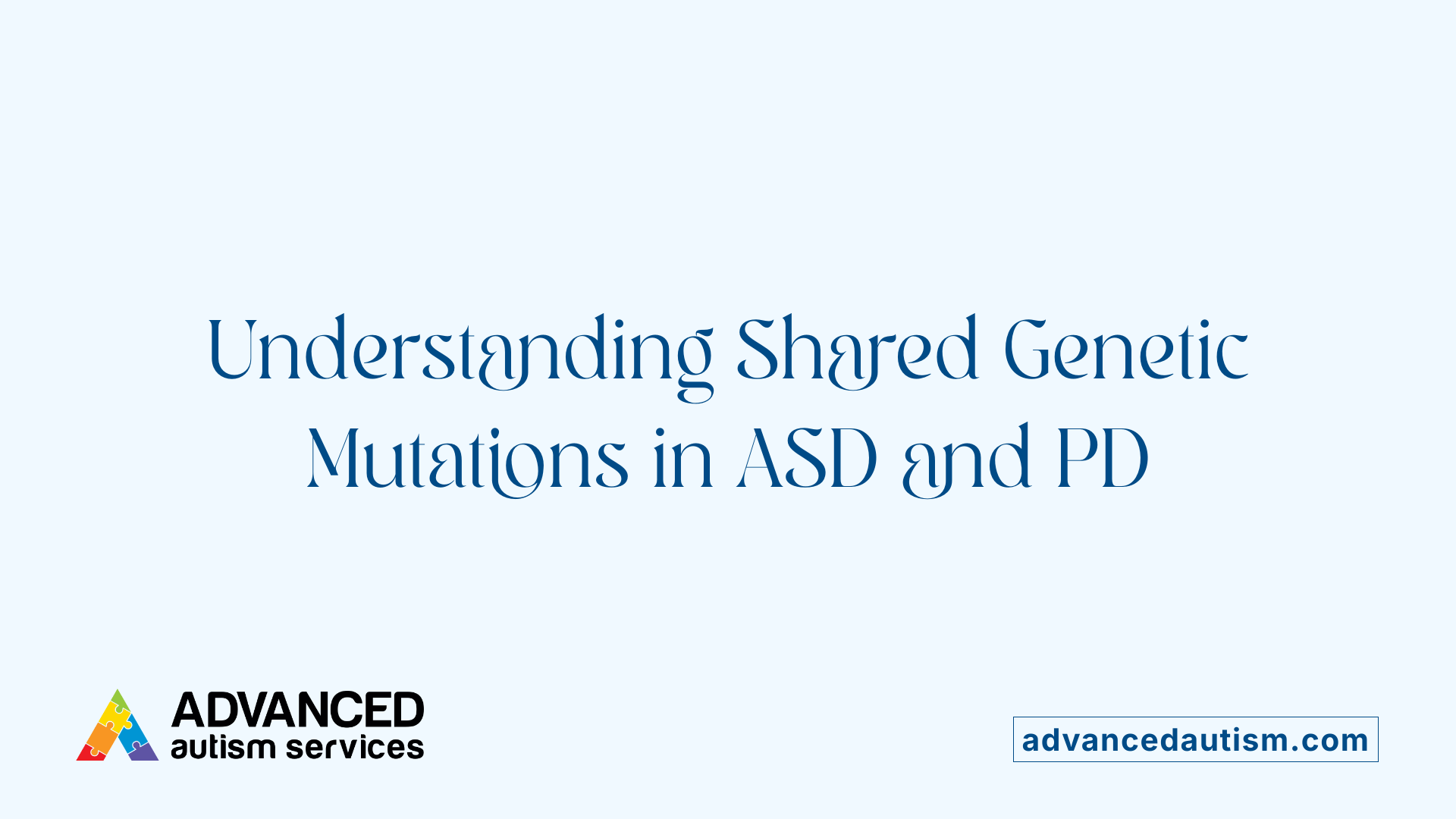Autism and Parkinson's
Uncovering the Hidden Links Between Neurodevelopment and Neurodegeneration
Exploring the Complex Intersection of Autism and Parkinson's Disease
Recent scientific advancements reveal intriguing connections between autism spectrum disorder (ASD) and Parkinson's disease (PD). While traditionally viewed as separate neurodevelopmental and neurodegenerative conditions, emerging evidence suggests they share common biological pathways, genetic factors, and neurochemical mechanisms. This article delves into current research, exploring how these disorders may overlap at genetic, cellular, and systemic levels, and what this means for diagnosis, treatment, and long-term management.
Shared Biological Pathways and Neurochemical Dysregulation

How is the dopamine system involved in both autism spectrum disorder (ASD) and Parkinson's disease (PD)?
The dopamine system plays a crucial role in both ASD and PD, affecting motor skills, social behavior, and emotional regulation. In Parkinson’s, degeneration of dopamine-producing neurons in the substantia nigra leads to classic motor symptoms like tremors, rigidity, and bradykinesia. Conversely, in autism, atypical dopamine signaling affects neural circuits involved in social interaction and cognitive flexibility. Genetic variations, such as mutations in the PARK2 gene, influence dopamine regulation and mitochondrial health, which are critical in both disorders. Studies suggest that disrupted dopamine transmission can contribute to the overlapping features seen in ASD and early-onset PD, particularly affecting movement and social functioning.
How does neuroinflammation serve as a common factor?
Neuroinflammation is increasingly recognized as a shared underlying process in both ASD and PD. Chronic brain inflammation results from immune responses to genetic, environmental, and cellular stress factors. In autism, neuroinflammation has been linked to immune dysregulation and increased cytokine activity, which may interfere with normal brain development. Similarly, in PD, inflammation contributes to the progression of neuronal degeneration, especially in dopaminergic neurons. Microglial activation and oxidative stress driven by inflammation exacerbate neurodegeneration and neurodevelopmental abnormalities, suggesting that managing inflammation might benefit both conditions.
What are the shared mitochondrial dysfunction mechanisms?
Mitochondria are vital for cellular energy production, and their dysfunction is a common thread linking ASD and PD. Mutations in mitochondrial-related genes such as PARK2, PINK1, and DJ-1 impair mitochondrial quality control mechanisms like mitophagy, leading to the accumulation of damaged mitochondria and increased oxidative stress. This cellular stress damages neurons, especially those involved in motor and cognitive functions. In Parkinson’s, mitochondrial failure directly causes neuronal death, whereas in autism, it may contribute to neurodevelopmental disruptions. The overlap in mitochondrial issues highlights potential targets for therapeutic strategies aimed at improving mitochondrial function and protecting neurons in both disorders.
Genetic Overlap and Biological Susceptibility

Are there shared genetic factors involved in both autism and Parkinson's disease?
Recent research indicates that autism spectrum disorder (ASD) and Parkinson’s disease (PD) share several genetic influences, suggesting overlapping biological pathways. Studies have identified specific genes, such as PARK2, RIT2, CD157/BST1, and ITSN1, that are associated with an increased risk for both conditions. For example, variations and copy number alterations in these genes can impact processes like synaptic function and dopamine regulation, which are crucial in neurodevelopment and neurodegeneration.
Epidemiological data supports this genetic link, showing that individuals with autism are significantly more likely to develop Parkinson's, particularly early-onset forms. This connection remains consistent even after adjusting for confounding factors like medication use or comorbid conditions, which suggests an intrinsic shared susceptibility rooted in genetics. Although our understanding is still evolving, accumulating evidence highlights a common genetic and molecular basis, emphasizing the importance of further research to decode these complex relationships.
What are the genetic mutations associated with both autism and Parkinson's?
A variety of gene mutations are implicated in both ASD and PD, each contributing in different ways to disease development. Notably, mutations in the PARK2 gene have been linked to early-onset Parkinson’s disease and are also associated with autistic behaviors in some cases. This gene plays a critical role in mitochondrial quality control through mitophagy, a process essential for neuronal health.
Other rare but impactful mutations include ATP13A2, which influences lysosomal function, and WDR45, involved in autophagy. Variants in these genes can produce a spectrum of symptoms that combine autistic features with parkinsonism, suggesting that they disrupt fundamental cellular processes such as mitochondrial function, synaptic integrity, and neurotransmitter balance, especially dopamine.
How do these shared genetic factors influence disease mechanisms?
Genetic mutations common to both disorders often impair essential cellular mechanisms that maintain neuronal health. For example, PARK2 mutations reduce the ability of cells to clear damaged mitochondria, leading to mitochondrial dysfunction, increased oxidative stress, and eventual neuronal death—hallmarks of Parkinson's disease. Interestingly, similar mitochondrial impairments can affect neurodevelopmental processes, contributing to the neurobiological abnormalities seen in ASD.
Mutations in RIT2 alter signaling pathways crucial for synaptic stability and neurochemical balance, impacting both movement and social behavior. These alterations may cause neuroinflammation, neurodegeneration, and disrupted neurotransmitter systems, especially involving dopamine. Since both disorders involve disturbances in dopaminergic neurons, genetic disruptions affecting these pathways help explain their overlapping features.
Ultimately, understanding these shared genetic influences offers insights into common pathological mechanisms, opening pathways for targeted interventions that could benefit both neurodevelopmental and neurodegenerative conditions.
| Genetic Variants | Associated Disorders | Functional Impact | Notable Features |
|---|---|---|---|
| PARK2 | ASD, PD | Impaired mitophagy, mitochondrial dysfunction | Early-onset PD, autistic traits |
| RIT2 | ASD, PD | Disrupted neurochemical signaling | Synaptic instability, motor issues |
| ATP13A2 | PD, neurodegeneration with autophagy failure | Lysosomal impairment | Neurodegeneration, motor symptoms |
| WDR45 | ASD, WD, syndromic forms | Autophagy regulation | Autistic features, neurodegeneration |
Research continues to uncover more about shared genetic pathways, advancing our understanding of these complex neuropsychiatric and neurodegenerative disorders.
Genetic and Molecular Mechanisms Underpinning Both Disorders
What are the underlying mechanisms, like inflammation or neurodegeneration, that might connect autism and Parkinson's disease?
Research reveals that autism spectrum disorder (ASD) and Parkinson's disease (PD) share several biological pathways that contribute to their co-occurrence. A significant aspect is mitochondrial dysfunction, where genetic mutations impair the cell's energy-producing organelles, leading to increased oxidative stress and neuronal damage.
Genes such as PARK2, PINK1, and ITSN1 are vital for maintaining healthy mitochondria. Mutations in these genes hinder mitophagy—the process of clearing damaged mitochondria—causing their accumulation. This cellular stress can result in neuronal death, characteristic of PD, and neurodevelopmental issues seen in ASD.
Neuroinflammation is another common player. Elevated inflammatory markers in ASD and PD suggest that chronic brain inflammation may exacerbate neuronal vulnerability. In autism, inflammation influences synaptic development and function, while in PD, it accelerates the loss of dopaminergic neurons in the substantia nigra.
Additionally, abnormalities in the dopaminergic system — affected by genes like RIT2, DRD2, and SHANK3 — are central to the motor symptoms of PD and contribute to social and behavioral challenges in ASD.
Are inflammatory processes involved in both ASD and PD?
Indeed, neuroinflammation is a shared aspect of both disorders. In ASD, increased levels of inflammatory cytokines and immune response irregularities have been observed, possibly disrupting normal neurodevelopment. In PD, neuroinflammatory responses are prominent around degenerating dopamine neurons, worsening disease progression.
This overlap suggests that therapies targeting inflammation could benefit both conditions. Lifestyle approaches, especially dietary strategies emphasizing anti-inflammatory foods—such as Omega-3 fatty acids, green leafy vegetables, nuts, and legumes—are gaining attention. These can potentially modulate neuroinflammatory processes, offering symptom relief and neuroprotection.
How does mitochondrial dysfunction contribute to both autism and PD?
Mitochondrial health is essential for neuronal survival and function. Mutations in genes like PARK2, PINK1, and DJ-1 impair mitochondrial quality control, leading to defective energy metabolism and increased oxidative stress.
In Parkinson’s, this results in the loss of dopamine-producing neurons, manifesting as motor symptoms. In autism, impaired mitochondrial function affects neurodevelopment and synaptic connectivity, resulting in behavioral and cognitive challenges.
Research indicates that restoring mitochondrial function may hold therapeutic promise. Approaches targeting oxidative stress reduction and improving mitochondrial quality control are under exploration to help manage or mitigate both ASD symptoms and PD progression.
| Aspect | Impact in ASD | Impact in PD | Shared Effects |
|---|---|---|---|
| Mitochondrial Genes | Mutations impair energy production, neurodevelopmental issues | Mutations lead to neuronal death and motor symptoms | Both involve oxidative stress and neuronal vulnerability |
| Neuroinflammation | Disrupts synaptic development, behavioral issues | Accelerates dopaminergic neuron loss | Chronic inflammation damages neurons in both disorders |
| Dopaminergic System | Variations affect social behavior and cognition | Core to motor deficits and neurodegeneration | Dysregulation affects brain function in both conditions |
Understanding these overlapping mechanisms enhances prospects for integrated therapeutic strategies, emphasizing the importance of addressing mitochondrial health and inflammation.
For further insights, search terms like "Impact of mitochondrial dysfunction and neuroinflammation in autism and Parkinson's disease" can provide comprehensive research updates and clinical advancements.
Towards Integrated Approaches in Diagnosis and Treatment
Understanding the shared biological mechanisms between autism and Parkinson's disease opens new frontiers in diagnosing and managing these complex disorders. As research continues to uncover genetic overlaps, neurochemical pathways, and inflammatory processes, there is hope for developing unified therapeutic strategies that address both neurodevelopmental and neurodegenerative components. Personalized interventions targeting mitochondrial health, neuroinflammation, and dopamine regulation hold promise for improving quality of life and outcomes for individuals affected by these interconnected conditions. Long-term monitoring and early identification of motor symptoms in autistic populations are vital as we move towards integrated, evidence-based care.
References
- Linking autism spectrum disorders and parkinsonism
- Risk of Parkinson Disease in Individuals With Autism ...
- Daily briefing: Autism triples risk of Parkinson's-like symptoms
- Large-scale study links autism to increased risk ...
- Autism linked to elevated risk of Parkinson's disease
- Large study links autism to Parkinson's disease
- Exploring the common genes involved in autism spectrum ...







